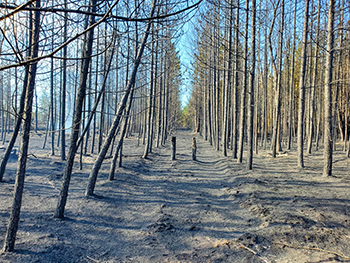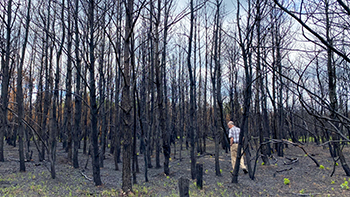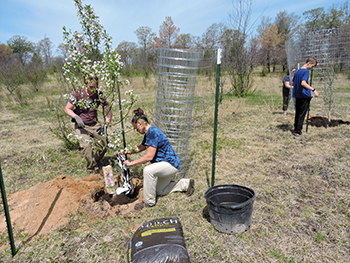After the fire: Partnership blooms with Detroit Zoo at Pigeon River Country State Forest
By RACHEL LINCOLN
Wildlife outreach coordinator, Wildlife Division
Michigan Department of Natural Resources
In the vast expanse of Michigan's Pigeon River Country State Forest, where diverse wildlife thrives amidst the expansive wilderness, a partnership between the Michigan Department of Natural Resources and the Detroit Zoological Society has emerged to breathe new life into a landscape scarred by wildfire.
Stretching for more than 110,000 acres across Cheboygan, Otsego and Montmorency counties, the forest affectionately referred to as “The Big Wild” is the largest block of undeveloped contiguous land in the Lower Peninsula and features a rich tapestry of wildlife and habitats.

But in May 2022, a wildfire sparked from the fiery touch of a lightning strike swept through the forest, leaving behind a trail of ash and blackened earth. The Blue Lakes Fire burned 2,516 acres of the forest over the course of seven days.
The raw heat generated from the fire burned so intensely that most plants and trees did not survive. Trees such as oak, apple and hawthorn and blueberry shrubs were a reliable food source for white-tailed deer, black bear, wild turkey and many other wildlife. While most wildlife fled the area during the fire, the loss of their habitat and food sources led them to seek refuge elsewhere within the forest.
"The size and scale of this fire was unprecedented.” said Shelby Adams, Pigeon River Country wildlife biologist. “The intensity and extent of this particular fire presented unique challenges for recovery and regeneration."
But despite the devastation, Adams said that fire is a natural part of the ecological process.
“Michigan has ecosystems that are inherently fire-prone," she said. "This means that both the land and its inhabitants have evolved to adapt to the natural cycle of wildfires.
“In many cases, fire acts as a cleanse for the land, clearing away forest floor debris and creating space for new life to flourish. During fires, wildlife knows to flee the affected areas in search of safer habitats."
Detroit Zoo CARE grant
Melissa Thueme, a primate supervisor with the Detroit Zoological Society, has been a lifelong visitor to the Pigeon River Country State Forest.
“Since I was young, my family would drive north to Pigeon River Country State Forest to go camping for a week during the summer,” she said. “It was in the Pigeon River Country that I fell in love with nature, animals and the environment.”
|

Thueme visited the area shortly after the wildfire was extinguished and was awed to see the changes to landscape.
“Places where it had been impossible to see more than a few feet through the foliage were now nearly clear — except for a few char-barked trees trying to hang on to life,” she said.
The impacts from the wildfire were still fresh in her mind when the call for proposals opened for the Conservation Action for a Resilient Environment grant through the Detroit Zoological Society.
The CARE grant program is offered to zoological society employees to provide the opportunity to engage in conservation projects meaningful to them while addressing conservation and environmental issues in the Detroit metro area and the Great Lakes region.
The Detroit Zoo began working in partnership with the Pigeon River Forestry Management Unit to create a CARE grant proposal to provide a head start to the regrowing burned area.
Led by Mark Monroe, the DNR Pigeon River Country State Forest unit manager and a seasoned firefighter, and Shelby Adams, the wildlife biologist there, the team collaborated on a plan to plant oak and apple saplings in the wake of the Blue Lakes Fire.
These trees were strategically selected, each chosen for its ability to provide food and shelter to local wildlife.
Rooted together: planting trees one year after the fire
On a crisp morning in May 2023, on the first anniversary of the Blue Lakes Fire, stewardship volunteers from the Detroit Zoological Society and DNR and local community members gathered at the Pigeon River Discovery Center.
|

Among them was Monroe, who talked about the long history of fire at the Pigeon River Country State Forest and shared photos and stories of his experience on duty at the Blue Lakes Fire.
Adams followed to provide insight on the intricate balance of fire in ecosystems and the benefits that can come from it, such as creating habitat for the Kirtland’s warbler, a small, yellow songbird that relies on intense heat generated by fire to open the cones of jack pine trees to continually seed and grow new stands of jack pine forests.
Following a discussion about fire, the team of stewardship volunteers made its way to the burn site to begin planting trees. In total, they planted 20 trees spread across four sections. These newly planted trees will offer essential food and shelter to wildlife as the charred area gradually begins to regenerate.
“As we parted ways, I stood back and looked at the trees we planted amongst the low grasses starting to regenerate. It felt good to be a part of something to give back to the forest which has given me so much,” Thueme said. “I hope that 30 years from now, another young girl is hiking through the Blue Lakes area past these now-mature trees and finds herself just as inspired as I was all those years ago.”
Ashes to abundance
This month marks one year after the tree planting. While there are charred remnants on the base of the still-standing dead trees, the once-smoldering area is now fresh with vivid greenery.
|

Trees bear scrapes from antlers rubbing against them, brightly colored fungi flourish amid the downed wood, and there are ample caches of hollowed-out nuts left by squirrels. Fire had scarred the land, but in its wake, new beginnings have taken root, a testament to the resilience of nature.
“Thanks to the CARE grant, our partners at the Detroit Zoo successfully brought together a community of people who love the Pigeon River Country Forest and the wildlife within,” Adams said. “We deeply appreciated their dedication to jump-starting the regeneration of the forest and the benefit it brings to wildlife.”
Plan your visit to The Big Wild
When planning a visit to the Pigeon River Country State Forest, remember it's a rugged and remote area perfect for a variety of activities like hiking, camping, fishing and elk viewing.
Visitors are encouraged to respect the environment and follow guidelines to preserve its wild character. Cellphone coverage is patchy in the forest, and signs are limited.
To get a map of the area and learn about the history of the forest and all of the opportunities to explore and experience The Big Wild, stop into the Pigeon River Discovery Center. The Discovery Center offers events throughout the year for visitors to connect to nature, like a mushroom foray or a guided hike to find elk. See the lineup of 2024 community events.
Find additional information and begin planning your trip on the Pigeon River County State Forest website.
|
Check out previous Showcasing the DNR stories in our archive at Michigan.gov/DNRStories. To subscribe to upcoming Showcasing articles, sign up for free email delivery at Michigan.gov/DNREmail.
Note to editors: Contact: John Pepin, Showcasing the DNR series editor, 906-226-1352. Accompanying photos and a text-only version of this story are available below for download. Caption information follows. Credit Michigan Department of Natural Resources, unless otherwise noted.
Text-only version of this story.
Photo 1: A burned tree remains standing amid new vegetation growth after the Blue Lakes Fire.
Photo 2: Burned trees and ash-covered ground are shown in the wake of the Blue Lakes Fire.
Photo 3: A man inspects the damage to a stand of trees after the Blue Lakes Fire.
Photo 4: New, green shoots sprout up amid the ashen ground and burned trees in the wake of the Blue Lakes Fire.
Photo 5: A group plants trees in the Blue Lakes Fire area of the Pigeon River Country State Forest. (Photo courtesy of Melissa Theume)
Photo 6: Fungi is shown growing on a charred log. Dead and decaying wood provides a nutrient-rich habitat for fungi.
|